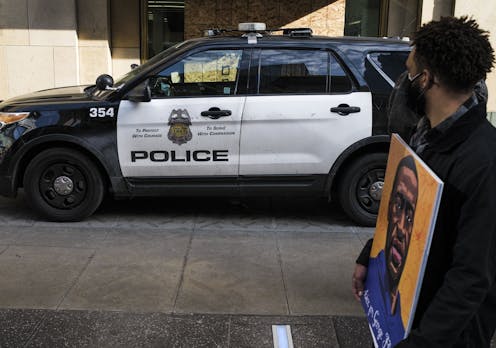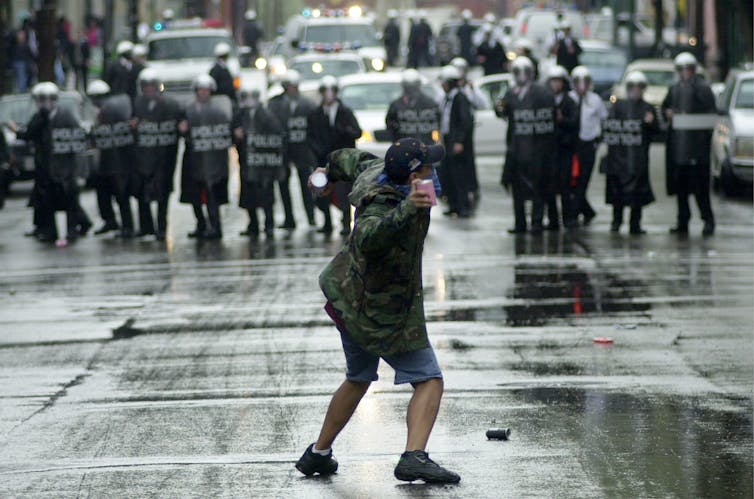American cities have long struggled to reform their police – but isolated success stories suggest co
Attempts to reform US police departments fail when they are unable to get community support. Perhaps it is time to take a different tack, argue two criminal justice scholars – one a former cop.

The guilty verdicts delivered against Derek Chauvin on April 20, 2021, represented a landmark moment – but courtroom justice cannot deliver the sweeping changes most Americans feel are needed to improve policing in the U.S.
As America continues to grapple with racism and police killings, federal action over police reform has stalled in Congress. But at the state level there is movement and steps toward reform are underway in many U.S. cities, including Philadelphia, Oakland and Portland, Oregon.
Many of these efforts are geared toward ending specific practices, such as the granting of qualified immunity, through which officers are shielded from civil lawsuits, and the use of certain police neck holds and no-knock warrants. Mayors and city councils nationwide have also pushed reforms emphasizing accountability and transparency, with many working to create independent oversight commissions.
It’s too soon to expect substantial improvement from these recently proposed remedies.
But as scholars of criminal justice – one a former police officer of 10 years – we know America has been here before. From Ferguson to Baltimore and Oakland to Chicago, numerous city police departments have undergone transformation efforts following controversial police killings. But these and other reform movements haven’t lived up to their promises.
Resisting change
After the shooting death in Missouri of unarmed teen Michael Brown in 2014, police in Ferguson agreed to a reform program that included anti-bias training and an agreement to end stop, search and arrest practices that discriminate on the basis of race.
But five years into the process, a report by the nonprofit Forward Through Ferguson found the reforms had done little to change policing culture or practice. This was backed up by a Ferguson Civilian Review Board report in July 2020 that found the “disparity in traffic stops between black and white residents appears to be growing.”
Similarly, concerns over the quality of Baltimore’s police services persist despite federal oversight and reforms brought in after the death of Freddie Gray in police custody in 2015.
Commentators have pointed to a resistance to change among officers and an inability to garner community buy-in as reasons for the slowdown in progress in Baltimore.
Part of the problem, as seen with Baltimore, is that federal intervention does not appear to guarantee lasting change. Research shows that Department of Justice regulations aimed at reform only slightly reduce police misconduct. There is also no evidence that national efforts targeting the use of force alone mitigate police killings.
Community-led reform
One beacon of hope is the Cincinnati Police Department. Twenty years ago, residents in Cincinnati experienced events similar to what many cities have faced in more recent years. An unarmed Black man, Timothy Thomas, was shot dead by officers in 2001, sparking widespread unrest. It led Cincinnati to enter into a different model of reform: a collaborative agreement.

Touted by former U.S. Attorney General Loretta Lynch as a national model for community-led police reform, the collaborative agreement saw the police department, civic government, police unions and local civil rights groups act in partnership for a reform program backed by court supervision.
The resulting changes to use-of-force policies, a focus on community-based solutions to crime, and robust oversight brought about improved policing. A 2009 Rand evaluation of the collaborative agreement found it resulted in a reduction in crime, positive changes in citizens’ attitudes toward police and fewer racially biased traffic stops. There were also fewer use-of-force incidents and officer and arrestee injuries under the collaborative agreement.
But it isn’t perfect. Cincinnati’s Black residents continue to be disproportionately arrested – likely owing to the concentration of crime, service calls and police deployments in predominantly Black neighborhoods. Figures from 2018 show Black Cincinnati residents were roughly three times as likely to be arrested as their white counterparts.
Cincinnati’s collaborative agreement contained a number of elements that experts say are needed if police reforms are to be successful: strong leadership, flexible, goal-oriented approaches, effective oversight and externally regulated transparency.
Moreover, it depended on police officials’ ability to cultivate community investment and overcome resistance from police officers and police unions.
Community confidence is critical to police reform and community safety. When citizens view police as legitimate and trustworthy, they are more likely to report crimes, cooperate during police investigations, comply with directives and work with police to find solutions to crime.
Beyond collaboration
Efforts like that in Cincinnati that put community engagement at the heart of police reforms undoubtedly are strides in the right direction. But they can go only so far. A noticeable shortcoming in most police reform programs is a focus on what is the right thing to do during confrontations with the public, rather than on trying to avert those situations in the first place.
Fatal police shootings often happen during police stops and arrests – situations that carry increased risks of citizen resistance and violent police response.
Scaling back low-level enforcement, such as arrests for vagrancy and loitering – much of which has little public safety advantage – and having police partner with civilian responders for mental health, homelessness and drug-related calls, could mean fewer opportunities for violent police encounters.
[You’re smart and curious about the world. So are The Conversation’s authors and editors. You can get our highlights each weekend.]
Some departments have begun to change their enforcement policies along these lines. The Gwinnett County Police Department in Georgia, for example, stopped making arrests and issuing citations for misdemeanor marijuana possession.
A 2018 study of traffic stops in Fayetteville, North Carolina, found that redirecting enforcement away from minor infractions – such as broken taillights and expired tags – toward the more serious violations of speeding and running traffic lights resulted in reduced crime and a narrowed racial gap in stops and searches.
Removing the trigger
Low-level infractions have often been the triggers for police interventions that end in citizen deaths. Eric Garner – who died in 2014 after a New York police officer put him in a banned chokehold – was stopped for selling loose cigarettes.
Devoting less time to policing such activity would also free up officers’ time to devote to such endeavors as analyzing crime trends, conducting wellness checks on elderly residents and mentoring community youth. I (Thaddeus Johnson) felt this as a police officer on the street, and I see it as a criminal justice scholar now.
The examples of Cincinnati, Ferguson and Baltimore show that getting community buy-in is crucial if attempts to improve policing are to be successful. We believe that evaluating officers’ performance and rewarding them based on community-oriented activities – rather than just the number of stops and arrests – could foster the support necessary for lasting reform.
Thaddeus L. Johnson is affiliated with the Council on Criminal Justice (Senior Research Fellow).
Natasha N. Johnson does not work for, consult, own shares in or receive funding from any company or organization that would benefit from this article, and has disclosed no relevant affiliations beyond their academic appointment.
Read These Next
Who thinks Republicans will suffer in the 2026 midterms? Republican members of Congress
The president’s party almost always loses seats in the midterms. More than two dozen Republican House…
Resolve to network at your employer’s next ‘offsite’ – research shows these retreats actually help f
Because they can help you get to know more of your co-workers, offsites may build the kind of trust…
The celibate, dancing Shakers were once seen as a threat to society – 250 years later, they’re part
‘The Testament of Ann Lee,’ Mona Fastvold’s 2025 film, depicts part of the long history of Shaker…






